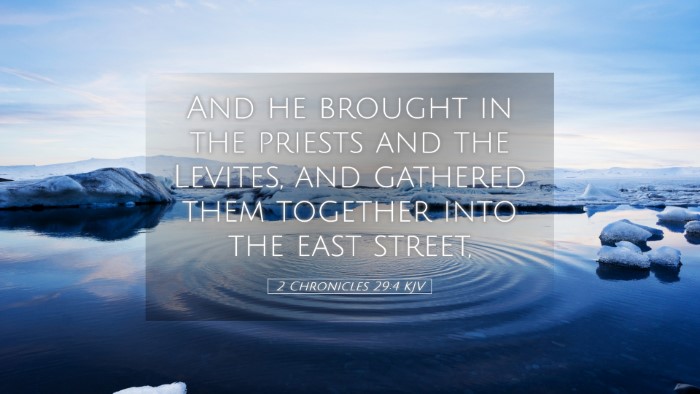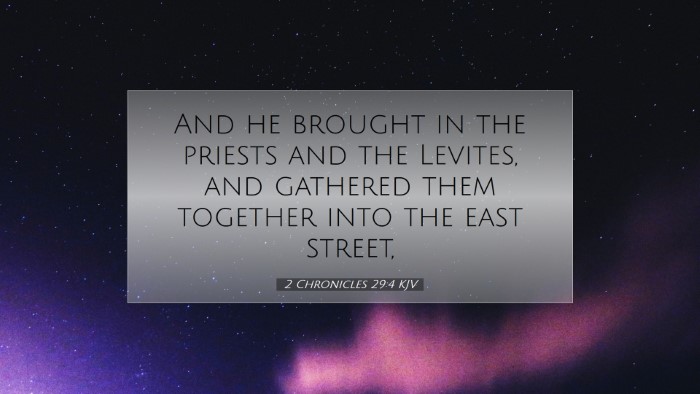Commentary on 2 Chronicles 29:4
Verse Reference: 2 Chronicles 29:4 - "And he brought in the priests and the Levites, and gathered them together into the east street."
Introduction
This verse marks a pivotal moment in the reign of King Hezekiah, capturing his zeal for the restoration of true worship in Judah. Hezekiah, amidst a backdrop of idolatry and neglect of the temple, takes decisive action to reinstate the Levitical order and revitalize the spiritual state of the nation. Below, we explore insights from renowned public domain commentaries, unraveling the theological and practical implications of this significant moment.
The Context of Restoration
The context of 2 Chronicles 29 involves a period marked by spiritual decline and apostasy from God’s instructions regarding worship. Prior to Hezekiah’s accession to the throne, there was considerable neglect regarding the temple worship and the Levite priesthood, which had been overshadowed by idolatrous practices.
- The Role of Hezekiah: Hezekiah is portrayed as a reformer. According to Matthew Henry, Hezekiah's heart was aligned towards restoring the worship of the true God, which had been obscured for years.
- Gathering of the Priests and Levites: Albert Barnes notes that this gathering in the "east street" may symbolize directing the people's attention towards the east where the sun rises, reflecting hope and renewal.
- Call to Action: Adam Clarke emphasizes the active role of leadership in spiritual matters, indicating that leaders must gather their people to encourage and instruct them in godliness.
The Importance of Leadership in Worship
The verse illustrates the essential role of leaders in directing the spiritual life of the community. Hezekiah's action not only demonstrates a personal commitment to God but also serves as a model for communal reform.
- Qualified Leadership: According to Matthew Henry, Hezekiah recognized the necessity of having qualified leaders (the priests and Levites) to lead the people in proper worship.
- Unity in Worship: Adam Clarke explains that the gathering of these priests and Levites signifies a united front in worship, which is crucial for the spiritual climate of the nation.
- Setting Priorities: Albert Barnes mentions that the first step towards revival is to prioritize worship and restore the temple worship as central to Jewish life.
Theological Implications
This verse raises significant theological concepts related to covenant worship and communal identity.
- Covenant Faithfulness: Matthew Henry indicates that this act of gathering reflects a return to covenant faithfulness, emphasizing the importance of communal worship in fulfilling God’s commands.
- Divine Encounters: Adam Clarke discusses that by reinstating the Levitical order, Hezekiah sought to ensure that the community could encounter God rightly, highlighting the necessity of mediation through the priesthood.
- Communal Identity: Albert Barnes asserts that true worship is foundational to the people’s identity as God’s chosen. The gathering symbolizes a reclaiming of their corporate identity as God’s people.
Insights on Restoration and Revival
The actions of Hezekiah in this verse are emblematic of the broader theme of restoration in Scripture, where God continually calls His people back to Him.
- Principle of Restoration: Matthew Henry notes that restoration starts with leadership that is both committed and courageous in calling people back to worship.
- Confession and Repentance: Albert Barnes implies that this gathering is not merely organizational but also a moment for the people to confess their sins and return in repentance.
- Expecting God’s Renewed Presence: Adam Clarke mentions that this act encapsulates a longing for God’s renewed presence and blessing upon the nation.
Practical Application for Today’s Church
The principles drawn from 2 Chronicles 29:4 offer vital applications for contemporary church leadership and practice.
- Inspiring Unity Among Leaders: Church leaders can take inspiration from Hezekiah’s example to unify their congregations around the core purpose of worship that glorifies God.
- Establishing Priorities: The importance of restoring the centrality of worship in the life of the church cannot be overstated. Leaders should assess whether worship practices align with biblical standards.
- Creating Environments for Repentance: Churches today should foster environments that encourage confession, repentance, and a collective return to God, modeled after Hezekiah's actions.
Conclusion
In 2 Chronicles 29:4, we witness King Hezekiah enact a profound reform in the nation of Judah. His initiative to gather the priests and Levites signifies both a literal and spiritual revival, inviting the community to recommit to true worship. The commentaries of Matthew Henry, Albert Barnes, and Adam Clarke collectively highlight the importance of restored worship, leadership, and the community of faith in the pursuit of a deeper relationship with God. These insights challenge contemporary believers to prioritize worship, embrace unity in faith, and lead with commitment towards restoration and revival.


